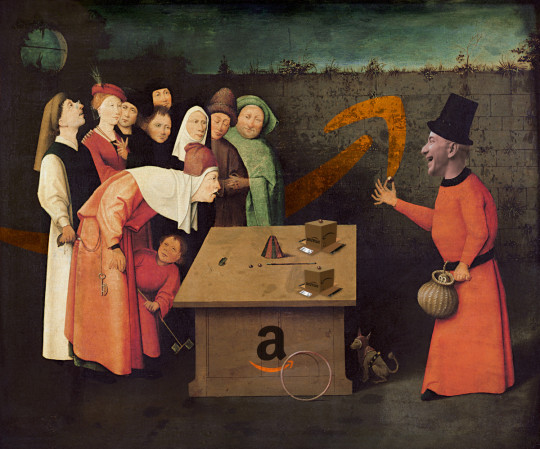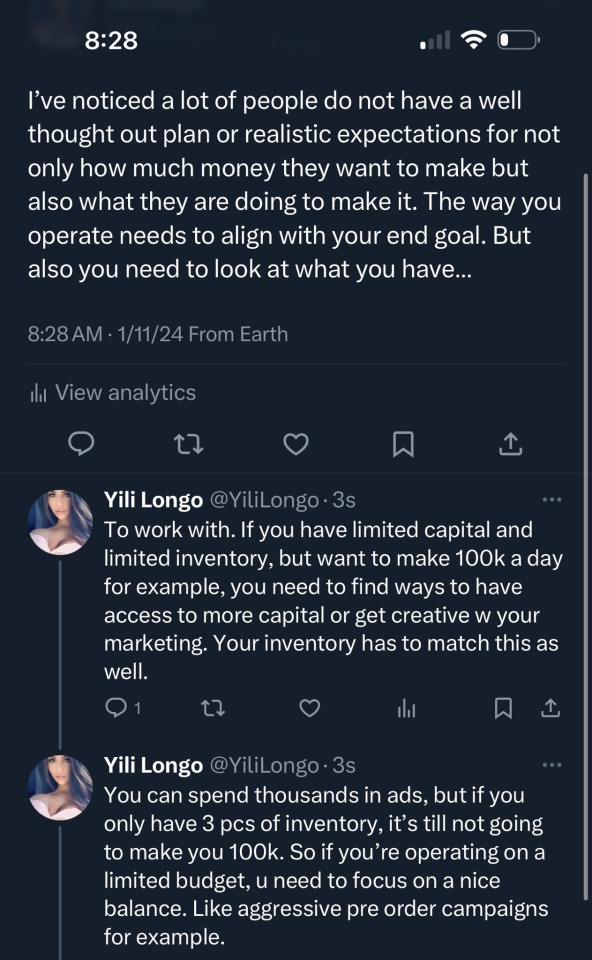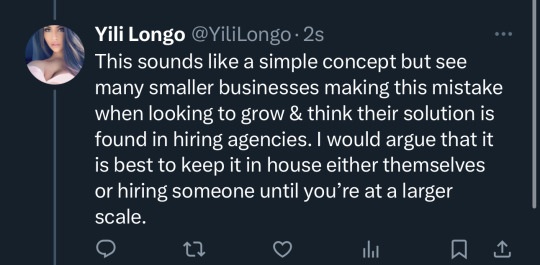#ecommerce
Text
#grayson#ecommerce#tennis skirt#actually gay#body positive#zombies#thatpoemguy#te quiero#emo aesthetic
193 notes
·
View notes
Photo

Here’s the secret most ecommerce platforms don’t want you to find out: with most of them, you don’t actually own your store. They own it – along with your data. WE KNOW. Kinda backwards, right? Instead of renting your store, own your future. Make it yours with WooCommerce and start selling online today.
9K notes
·
View notes
Text
Amazon’s financial shell game let it create an “impossible” monopoly

I'm on tour with my new, nationally bestselling novel The Bezzle! Catch me in TUCSON (Mar 9-10), then San Francisco (Mar 13), Anaheim, and more!

For the pro-monopoly crowd that absolutely dominated antitrust law from the Carter administration until 2020, Amazon presents a genuinely puzzling paradox: the company's monopoly power was never supposed to emerge, and if it did, it should have crumbled immediately.
Pro-monopoly economists embody Ely Devons's famous aphorism that "If economists wished to study the horse, they wouldn’t go and look at horses. They’d sit in their studies and say to themselves, ‘What would I do if I were a horse?’":
https://pluralistic.net/2022/10/27/economism/#what-would-i-do-if-i-were-a-horse
Rather than using the way the world actually works as their starting point for how to think about it, they build elaborate models out of abstract principles like "rational actors." The resulting mathematical models are so abstractly elegant that it's easy to forget that they're just imaginative exercises, disconnected from reality:
https://pluralistic.net/2023/04/03/all-models-are-wrong/#some-are-useful
These models predicted that it would be impossible for Amazon to attain monopoly power. Even if they became a monopoly – in the sense of dominating sales of various kinds of goods – the company still wouldn't get monopoly power.
For example, if Amazon tried to take over a category by selling goods below cost ("predatory pricing"), then rivals could just wait until the company got tired of losing money and put prices back up, and then those rivals could go back to competing. And if Amazon tried to keep the loss-leader going indefinitely by "cross-subsidizing" the losses with high-margin profits from some other part of its business, rivals could sell those high margin goods at a lower margin, which would lure away Amazon customers and cut the supply lines for the price war it was fighting with its discounted products.
That's what the model predicted, but it's not what happened in the real world. In the real world, Amazon was able use its access to the capital markets to embark on scorched-earth predatory pricing campaigns. When diapers.com refused to sell out to Amazon, the company casually committed $100m to selling diapers below cost. Diapers.com went bust, Amazon bought it for pennies on the dollar and shut it down:
https://www.theverge.com/2019/5/13/18563379/amazon-predatory-pricing-antitrust-law
Investors got the message: don't compete with Amazon. They can remain predatory longer than you can remain solvent.
Now, not everyone shared the antitrust establishment's confidence that Amazon couldn't create a durable monopoly with market power. In 2017, Lina Khan – then a third year law student – published "Amazon's Antitrust Paradox," a landmark paper arguing that Amazon had all the tools it needed to amass monopoly power:
https://www.yalelawjournal.org/note/amazons-antitrust-paradox
Today, Khan is chair of the FTC, and has brought a case against Amazon that builds on some of the theories from that paper. One outcome of that suit is an unprecedented look at Amazon's internal operations. But, as the Institute for Local Self-Reliance's Stacy Mitchell describes in a piece for The Atlantic, key pieces of information have been totally redacted in the court exhibits:
https://www.theatlantic.com/ideas/archive/2024/02/amazon-profits-antitrust-ftc/677580/
The most important missing datum: how much money Amazon makes from each of its lines of business. Amazon's own story is that it basically breaks even on its retail operation, and keeps the whole business afloat with profits from its AWS cloud computing division. This is an important narrative, because if it's true, then Amazon can't be forcing up retail prices, which is the crux of the FTC's case against the company.
Here's what we know for sure about Amazon's retail business. First: merchants can't live without Amazon. The majority of US households have Prime, and 90% of Prime households start their ecommerce searches on Amazon; if they find what they're looking for, they buy it and stop. Thus, merchants who don't sell on Amazon just don't sell. This is called "monopsony power" and it's a lot easier to maintain than monopoly power. For most manufacturers, a 10% overnight drop in sales is a catastrophe, so a retailer that commands even a 10% market-share can extract huge concessions from its suppliers. Amazon's share of most categories of goods is a lot higher than 10%!
What kind of monopsony power does Amazon wield? Well, for one thing, it is able to levy a huge tax on its sellers. Add up all the junk-fees Amazon charges its platform sellers and it comes out to 45-51%:
https://pluralistic.net/2023/04/25/greedflation/#commissar-bezos
Competitive businesses just don't have 45% margins! No one can afford to kick that much back to Amazon. What is a merchant to do? Sell on Amazon and you lose money on every sale. Don't sell on Amazon and you don't get any business.
The only answer: raise prices on Amazon. After all, Prime customers – the majority of Amazon's retail business – don't shop for competitive prices. If Amazon wants a 45% vig, you can raise your Amazon prices by a third and just about break even.
But Amazon is wise to that: they have a "most favored nation" rule that punishes suppliers who sell goods more cheaply in rival stores, or even on their own site. The punishments vary, from banishing your products to page ten million of search-results to simply kicking you off the platform. With publishers, Amazon reserves the right to lower the prices they set when listing their books, to match the lowest price on the web, and paying publishers less for each sale.
That means that suppliers who sell on Amazon (which is anyone who wants to stay in business) have to dramatically hike their prices on Amazon, and when they do, they also have to hike their prices everywhere else (no wonder Prime customers don't bother to search elsewhere for a better deal!).
Now, Amazon says this is all wrong. That 45-51% vig they claim from business customers is barely enough to break even. The company's profits – they insist – come from selling AWS cloud service. The retail operation is just a public service they provide to us with cross-subsidy from those fat AWS margins.
This is a hell of a claim. Last year, Amazon raked in $130 billion in seller fees. In other words: they booked more revenue from junk fees than Bank of America made through its whole operation. Amazon's junk fees add up to more than all of Meta's revenues:
https://s2.q4cdn.com/299287126/files/doc_financials/2023/q4/AMZN-Q4-2023-Earnings-Release.pdf
Amazon claims that none of this is profit – it's just covering their operating expenses. According to Amazon, its non-AWS units combined have a one percent profit margin.
Now, this is an eye-popping claim indeed. Amazon is a public company, which means that it has to make thorough quarterly and annual financial disclosures breaking down its profit and loss. You'd think that somewhere in those disclosures, we'd find some details.
You'd think so, but you'd be wrong. Amazon's disclosures do not break out profits and losses by segment. SEC rules actually require the company to make these per-segment disclosures:
https://scholarship.law.stjohns.edu/cgi/viewcontent.cgi?article=3524&context=lawreview#:~:text=If%20a%20company%20has%20more,income%20taxes%20and%20extraordinary%20items.
That rule was enacted in 1966, out of concern that companies could use cross-subsidies to fund predatory pricing and other anticompetitive practices. But over the years, the SEC just…stopped enforcing the rule. Companies have "near total managerial discretion" to lump business units together and group their profits and losses in bloated, undifferentiated balance-sheet items:
https://www.ucl.ac.uk/bartlett/public-purpose/publications/2021/dec/crouching-tiger-hidden-dragons
As Mitchell points you, it's not just Amazon that flouts this rule. We don't know how much money Google makes on Youtube, or how much Apple makes from the App Store (Apple told a federal judge that this number doesn't exist). Warren Buffett – with significant interest in hundreds of companies across dozens of markets – only breaks out seven segments of profit-and-loss for Berkshire Hathaway.
Recall that there is one category of data from the FTC's antitrust case against Amazon that has been completely redacted. One guess which category that is! Yup, the profit-and-loss for its retail operation and other lines of business.
These redactions are the judge's fault, but the real fault lies with the SEC. Amazon is a public company. In exchange for access to the capital markets, it owes the public certain disclosures, which are set out in the SEC's rulebook. The SEC lets Amazon – and other gigantic companies – get away with a degree of secrecy that should disqualify it from offering stock to the public. As Mitchell says, SEC chairman Gary Gensler should adopt "new rules that more concretely define what qualifies as a segment and remove the discretion given to executives."
Amazon is the poster-child for monopoly run amok. As Yanis Varoufakis writes in Technofeudalism, Amazon has actually become a post-capitalist enterprise. Amazon doesn't make profits (money derived from selling goods); it makes rents (money charged to people who are seeking to make a profit):
https://pluralistic.net/2023/09/28/cloudalists/#cloud-capital
Profits are the defining characteristic of a capitalist economy; rents are the defining characteristic of feudalism. Amazon looks like a bazaar where thousands of merchants offer goods for sale to the public, but look harder and you discover that all those stallholders are totally controlled by Amazon. Amazon decides what goods they can sell, how much they cost, and whether a customer ever sees them. And then Amazon takes $0.45-51 out of every dollar. Amazon's "marketplace" isn't like a flea market, it's more like the interconnected shops on Disneyland's Main Street, USA: the sign over the door might say "20th Century Music Company" or "Emporium," but they're all just one store, run by one company.
And because Amazon has so much control over its sellers, it is able to exercise power over its buyers. Amazon's search results push down the best deals on the platform and promote results from more expensive, lower-quality items whose sellers have paid a fortune for an "ad" (not really an ad, but rather the top spot in search listings):
https://pluralistic.net/2023/11/29/aethelred-the-unready/#not-one-penny-for-tribute
This is "Amazon's pricing paradox." Amazon can claim that it offers low-priced, high-quality goods on the platform, but it makes $38b/year pushing those good deals way, way down in its search results. The top result for your Amazon search averages 29% more expensive than the best deal Amazon offers. Buy something from those first four spots and you'll pay a 25% premium. On average, you need to pick the seventeenth item on the search results page to get the best deal:
https://scholarship.law.bu.edu/faculty_scholarship/3645/
For 40 years, pro-monopoly economists claimed that it would be impossible for Amazon to attain monopoly power over buyers and sellers. Today, Amazon exercises that power so thoroughly that its junk-fee revenues alone exceed the total revenues of Bank of America. Amazon's story – that these fees barely stretch to covering its costs – assumes a nearly inconceivable level of credulity in its audience. Regrettably – for the human race – there is a cohort of senior, highly respected economists who possess this degree of credulity and more.
Of course, there's an easy way to settle the argument: Amazon could just comply with SEC regs and break out its P&L for its e-commerce operation. I assure you, they're not hiding this data because they think you'll be pleasantly surprised when they do and they don't want to spoil the moment.

If you'd like an essay-formatted version of this post to read or share, here's a link to it on pluralistic.net, my surveillance-free, ad-free, tracker-free blog:
https://pluralistic.net/2024/03/01/managerial-discretion/#junk-fees

Image:
Doc Searls (modified)
https://www.flickr.com/photos/docsearls/4863121221/
CC BY 2.0
https://creativecommons.org/licenses/by/2.0/
#pluralistic#amazon#ilsr#institute for local self-reliance#amazon's antitrust paradox#antitrust#trustbusting#ftc#lina khan#aws#cross-subsidization#stacy mitchell#junk fees#most favored nation#sec#securities and exchange commission#segmenting#managerial discretion#ecommerce#technofeudalism
590 notes
·
View notes
Text
Tools That Will Help You Start Your Business For Free
ChatGPT
Canva
Stan Store
Stripe
Tiktok
Mailchimp
Pinterest
Hubspot
Capcut
Webflow
Unsplash
Google Fonts
Notion
WooCommerce
Convertkit
Calendly
Zapier
Sendinblue
Mozbar
Google Trends
Framer
YouTube
Answer The Public
IFTTT
Buffer
Videoleap
Snaptik
Google Analytics
Keyword.io
Trello
Google Docs
Instagram
Twitter
Hootsuite
Pixabay
Pexels
Wave
Grammerly
Calendly
Xero
Product Hunt
Semrush
PlaceIT
Asana
Loom
Namelix
#resources#marketing tools#seo tools#business tips#start a business#small business#entrepreneurship#entrepreneur#startup#start up#business#make money from home#make money online#marketing#ecommerce#branding#digitalmarketing#business growth
1K notes
·
View notes
Text

For some inexplicable reason this comparison-shopping widget is configured to compare the prices of tack hammers by haft length in centimetres rather than by number of units.
574 notes
·
View notes
Text



Keep smiling because life is a beautiful thing and there’s so much to smile about. If you show me 1% of goodness, I’ll show 100% in return. But if you show 1% of attitude, I’ll show 100% of it🦋🦋
215 notes
·
View notes
Text
#john boyega#gojo x reader#itadori yuuji#skz felix#sfw agere#thick thickwhite girls#eddie munson x reader#puns#max irons#ramadan#ecommerce
145 notes
·
View notes
Text
#skz felix#d20#dnd memes#islam#supreme#eddie munson x reader#megatron#thomas sanders#max irons#silent hill#campfire#ecommerce#crush quotes#liberdadeliteraria
128 notes
·
View notes
Photo

Are you thinking what these thinkies are thinking?
Try Woo to find out.
6K notes
·
View notes
Text
Sponsored listings are a ripoff…for sellers

Tonight (November 29), I'm at NYC's Strand Books with my novel The Lost Cause, a solarpunk tale of hope and danger that Rebecca Solnit called "completely delightful."

Not all ads are created equally sleazy. The privacy harms from surveillance ads, though real, are often hard to pin down. But there's another kind of ad - or "ad" that picks your pocket every time you use an ecommerce site.
This is the "sponsored listing" ad, which allows merchants to bid to be among the top-ranked items in response to your searches - whether or not their products are a good match for your query. These aren't "ads" in the way that, say, a Facebook ad is an ad. These are more #payola, a form of bribery that's actually a crime (but not when Amazon does it):
https://en.wikipedia.org/wiki/Payola#U.S._investigations_and_aftermath
Amazon is the global champion of payola. It boasts of $31 billion in annual "ad" revenue. That's $31 billion that Amazon sellers have to recoup from you. But Amazon's use of "most favored nation" deals (which requires sellers to offer their lowest prices on Amazon) mean that you don't see those price-hikes because sellers raise their prices everywhere:
https://pluralistic.net/2023/04/25/greedflation/#commissar-bezos
Forget Twitter: Amazon search is the poster-child for enshittification, in which Amazon locks you in (for example, with a year's shipping prepaid through Prime) and then you get recommended worse products while sellers make less money and Amazon pockets the difference.
Sellers who don't sell on Amazon are dead in the water, because most US households have Amazon Prime and overwhelmingly, Prime users start their search on Amazon, and, if they find the goods they're seeking. After all, they've prepaid for shipping.
So sellers suck it up and pay a 45-51% Amazon tax and pass it on to us - no matter where we shop. A lot of the junk fees sellers pay are related to Prime and other fulfillment services, but an increasing share of the Amazon tax comes from the need to pay to "advertise," because if they don't buy the top result for searches for their own products, their competitors' ads will push them right off the first page (those competitors spend money on advertising, rather than manufacturing quality).
There's a lot of YOLO/ROFLMAO in those ads: search for "cat beds" and 50% of the first five screens are ads - including ads for dog products, apparently bought by companies adopting a spray-and-pray approach to advertising. Someone selling a quality product still has to outbid all of those garbage sellers:
https://pluralistic.net/2022/11/28/enshittification/#relentless-payola
This is at the root of Amazon's Pricing Paradox: while Amazon can defend itself against regulators by citing sellers whose prices are lower and/or whose quality is higher, it's nearly impossible for shoppers to get those deals. If you click the top result for your search, you will, on average, pay 29% more than you would if you found the best bargain on the site:
https://pluralistic.net/2023/11/06/attention-rents/#consumer-welfare-queens
What's more, you can't fix this by simply sorting by price, or by reviews, or some mix of the two. The sleaziest sellers have mastered tricks like changing the number of units they sell so the total price is lower. For example, if batteries are normally sold $10 for a four-pack, a sleazy seller can offer batteries at $9 for three units. A lowest-to-highest price-sort will put this item ahead of a cheaper rival.
Researchers found that getting a good deal at Amazon requires that you make a multifactorial spreadsheet by laboriously copy/pasting multiple details from individual listing pages and then doing sorts that Amazon itself doesn't permit:
https://scholarship.law.bu.edu/faculty_scholarship/3645/
There's an exception to this: Amazon and Apple have a cozy, secret arrangement to exclude these "ads" from searches for Apple products. But if you're shopping for anything else, you're SOL:
https://www.businessinsider.com/amazon-gives-apple-special-treatment-while-others-suffer-junk-ads-2023-11
These payola markets are bad for buyers, and they cost sellers a lot of money, but are they at least good for sellers? A new study from three business-school researchers - Vibhanshu Abhishek, Jiaqi Shi and Mingyu Joo - shows that payola is a very bad deal for good sellers, too:
https://papers.ssrn.com/sol3/papers.cfm?abstract_id=3896716
After doing a lot of impressive quantitative work, the authors conclude that for good sellers, showing up as a sponsored listing makes buyers trust their products less than if they floated to the top of the results "organically." This means that buying an ad makes your product less attractive than not buying an ad.
The exception is sellers who have bad products - products that wouldn't rise to the top of the results on their own merits. The study finds that if you buy your mediocre product's way to the top of the results, buyers trust it more than they would if they found it buried deep on page eleventy-million, to which its poor reviews, quality or price would normally banish it.
But of course, if you're one of those good sellers, you can't simply opt not to buy an ad, even though seeing it with the little "AD" marker in the thumbnail makes your product less attractive to shoppers. If you don't pay the danegeld, your product will be pushed down by the inferior products whose sellers are only too happy to pay ransom.

If you'd like an essay-formatted version of this post to read or share, here's a link to it on pluralistic.net, my surveillance-free, ad-free, tracker-free blog:
https://pluralistic.net/2023/11/29/aethelred-the-unready/#not-one-penny-for-tribute
#pluralistic#payola#danegeld#amazon#amazons pricing paradox#consumer welfare#ads#search ads#ecommerce#scholarship#empricism
199 notes
·
View notes

